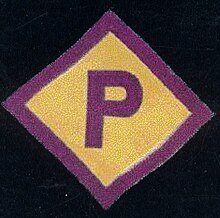Poland badge
The Poland badge , a purple letter P on a yellow background, was the Nazi regime introduced compulsory indicator for persons who, during the Second World War as a Polish forced laborers in the German Reich were staying.
Historical background
The mark was one of the discriminatory measures that were introduced in the German Reich during the Nazi era with the so-called Poland Decrees on March 8, 1940. It was defined as follows:
“The license plate consists of a square made of yellow fabric with 5 cm long sides and a 0.5 cm wide purple border; in the middle it shows a 2.5 cm high purple letter P. "
From this point on, the stigmatizing badge had to be sewn on by all Polish forced laborers and worn clearly visible on the right side of the chest of every item of clothing. Every Polish worker had to purchase five badges at a price of 10 pfennigs each. Anyone who did not wear it was punished with a fine of 150 Reichsmarks or imprisonment for up to 6 weeks.
The Poland badge was the first of the three marks that were gradually required to identify and exclude the various discriminated and persecuted groups in the German Reich. The Jewish star followed in 1941 and the Eastern badge for slave laborers from the Soviet Union in 1942 .
Until the end of the war, the racist hierarchy (descending) between Germans, Scandinavians, British and French, Italians, Poles, Russians and Jews was maintained.
Making the badge
The production of the Poland badges was taken over by the Berlin flag factory Geitel & Co. The company, which enjoyed an enormous upswing in flag production for the Third Reich, also produced the Jewish stars and the Eastern badges in addition to the Polish badges. The company exists today as BEST Berliner Stoffdruckerei GmbH and is still owned by the Geitel family. Among other things, it produced the unity flag, which was flown at the Reichstag in 1990 .
literature
- Hans Küppers, Rolf Bannier: Labor law of the Poles in the German Empire . Otto Elsner, 1942.
Web links
- Martin Niewendick: Poland decrees of 1940: stigmatized and dehumanized. In: tagesspiegel.de . March 11, 2015, accessed April 20, 2020 .
- Cord Pagenstecher, Ewa Czerwiakowski: 75 years ago: The Poland decrees. In: zeitgeschichte-online.de. April 1, 2015, accessed April 20, 2020 .
See also
Individual evidence
- ↑ a b c Cordula Tollmien: Project work forced labor in Göttingen . Ed .: City Archives Göttingen. ( online ).
- ↑ Police Ordinance of the RMI of March 8, 1940, Reichsgesetzblatt 1940 I, No. 55, pp. 555–556.
- ↑ a b Michael Wildt, Christoph Kreutzmüller: Berlin 1933-1945. City and society under National Socialism . Siedler , Munich 2013, ISBN 978-3-641-08903-0 ( limited preview in Google book search).
- ↑ Michael Sontheimer: Nazi urban planning and the Holocaust: From the fashion house to the murder laboratory . In: The daily newspaper: taz . September 4, 2013, ISSN 0931-9085 ( taz.de [accessed June 26, 2020]).

